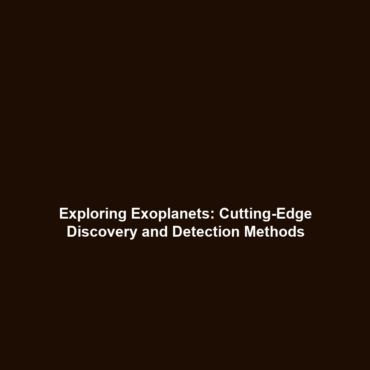Habitable Zones: The Goldilocks Zone in Exoplanet Research
The quest to discover extraterrestrial life heavily relies on understanding habitable zones, specifically the Goldilocks Zone. This region around a star is neither too hot nor too cold, making it just right for liquid water to exist—an essential ingredient for life as we know it. Within the broader context of exoplanets, identifying these zones is crucial as it expands our understanding of where life might thrive outside Earth. This article will explore the Goldilocks Zone’s significance, applications, challenges, and future research opportunities.
Key Concepts
The concept of the Goldilocks Zone is fundamental in the study of exoplanets. Here are some major concepts related to this topic:
Understanding the Goldilocks Zone
The Goldilocks Zone, or habitable zone (HZ), is the region around a star where conditions could allow for liquid water on a planet’s surface. Key parameters that define this zone include:
- Distance from the Star: The closer a planet is to its star, the hotter it becomes. Conversely, planets further away may be too cold for water to exist.
- Star Type: Different types of stars (e.g., G-type, K-type) emit varying amounts of radiation, influencing the size and position of the HZ.
- Planetary Atmosphere: A planet’s atmosphere can trap heat or provide essential conditions for liquid water, significantly affecting its habitability.
Applications and Real-World Uses
Understanding the Goldilocks Zone has numerous practical applications in the study of exoplanets:
- Planet Search Criteria: Astronomers use the concept of habitable zones to prioritize targets for detailed study when searching for exoplanets.
- Space Missions: Missions such as NASA’s Kepler Space Telescope and TESS are designed to explore areas within the Goldilocks Zone of various stars.
- Astrobiology Research: The Goldilocks Zone serves as a blueprint for understanding life’s potential adaptability in the universe.
Current Challenges
Despite the significance of the Goldilocks Zone, several challenges hinder our understanding and applications:
- Defining Boundaries: The exact boundaries of habitable zones can be difficult to determine due to variations in stellar characteristics.
- Exoplanet Atmospheres: The impact of different atmospheric compositions on habitability remains largely uncertain.
- Technological Limitations: Current technology can only provide limited data regarding distant exoplanets and their environments.
Future Research and Innovations
Future research on the Goldilocks Zone is poised to unveil exciting innovations that could reshape our understanding of habitability:
- Advanced Telescopes: Next-generation telescopes, like the James Webb Space Telescope, will offer deeper insights into exoplanet atmospheres and surface conditions.
- Habitability Models: Improved models simulating climate conditions on exoplanets may refine our criteria for identifying habitable zones.
- Interdisciplinary Collaboration: Collaborations across various scientific disciplines could lead to breakthroughs in understanding life-supporting conditions.
Conclusion
In summary, the Goldilocks Zone is a vital concept in the study of exoplanets, representing the regions where conditions may be just right for liquid water, which is essential for life. As we continue to explore these habitable zones, we not only expand our understanding of the universe but also draw closer to answering the intriguing question of whether we are alone in it. For more in-depth insights, explore our articles on Exoplanet Discoveries and Astrobiology Research.

